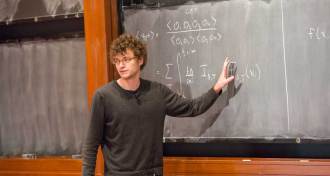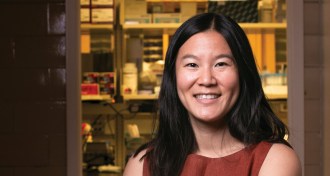Feature
-
 Astronomy
AstronomyPaula Jofré makes stellar connections
Astrophysicist Paula Jofré is a galactic archaeologist, mapping out generations of stars.
-
 Health & Medicine
Health & MedicineLisa Manning describes the physics of how cells move
Physicist Lisa Manning probes how physical forces influence cell behavior in asthma and other conditions.
-
 Chemistry
ChemistryJoaquín Rodríguez-López designs batteries for a sustainable energy future
Electrochemist Joaquín Rodríguez-López is finding better ways to store wind and solar power.
-
 Artificial Intelligence
Artificial IntelligenceAnshumali Shrivastava uses AI to wrangle torrents of data
Computer scientist Anshumali Shrivastava is designing programs that can handle torrents of information quickly and efficiently.
-
 Quantum Physics
Quantum PhysicsDouglas Stanford probes the chaos inside black holes
Theoretical physicist Douglas Stanford is linking some of the most massive objects known to the quantum realm.
-
 Animals
AnimalsJenny Tung wants to know how social stresses mess with genes
Evolutionary anthropologist Jenny Tung is untangling the many health effects of life as a social animal.
By Susan Milius -
 Agriculture
AgricultureCan science build a better burger?
Researchers hope to replace whole animal agriculture and feed the world with lab-made meats or plants.
By Susan Milius -
 Particle Physics
Particle PhysicsThree new physics experiments could revamp the standard model
New experiments that rely on very large machines have begun to probe the weak points of particle physics.
-
 Climate
ClimateWildfires make their own weather, and that matters for fire management
Mathematical equations describing interactions between wildfires and the air around them help explain their power and destruction.
-
 Agriculture
AgricultureHow plant microbes could feed the world and save endangered species
Scientists have only scratched the surface of the plant microbiome, but they already believe it might increase crop yield and save species from extinction.
By Amber Dance -
 Ecosystems
EcosystemsA freshwater, saltwater tug-of-war is eating away at the Everglades
Saltwater is winning in the Everglades as sea levels rise and years of redirecting freshwater flow to support agriculture and population growth
-
 Life
LifeMore than 2 billion people lack safe drinking water. That number will only grow.
By 2050, half the world’s population may no longer have safe water to drink or grow food. What then?